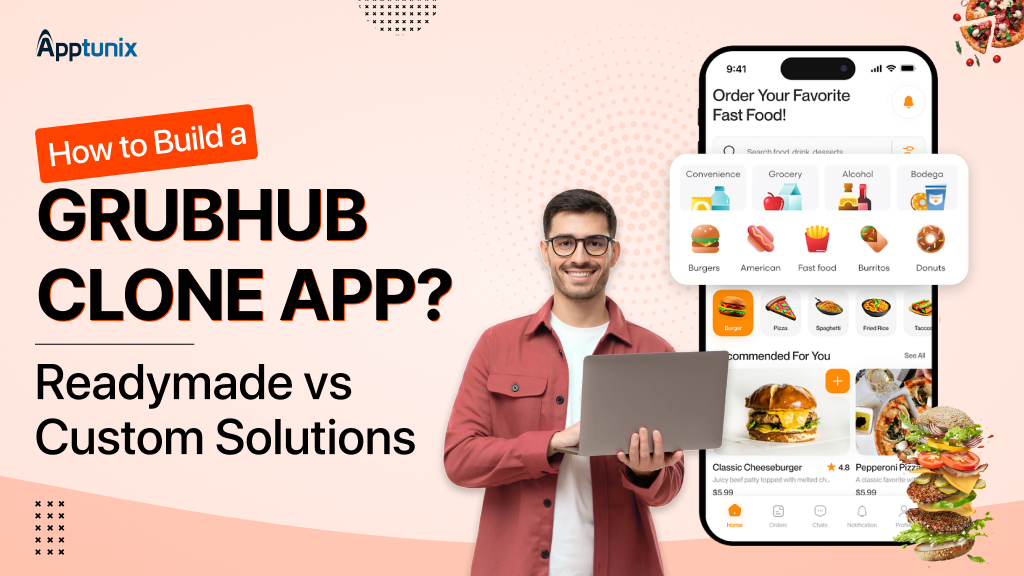
How to Build a Grubhub Clone App? Readymade vs Custom Solutions
25 Views 3 min November 19, 2025

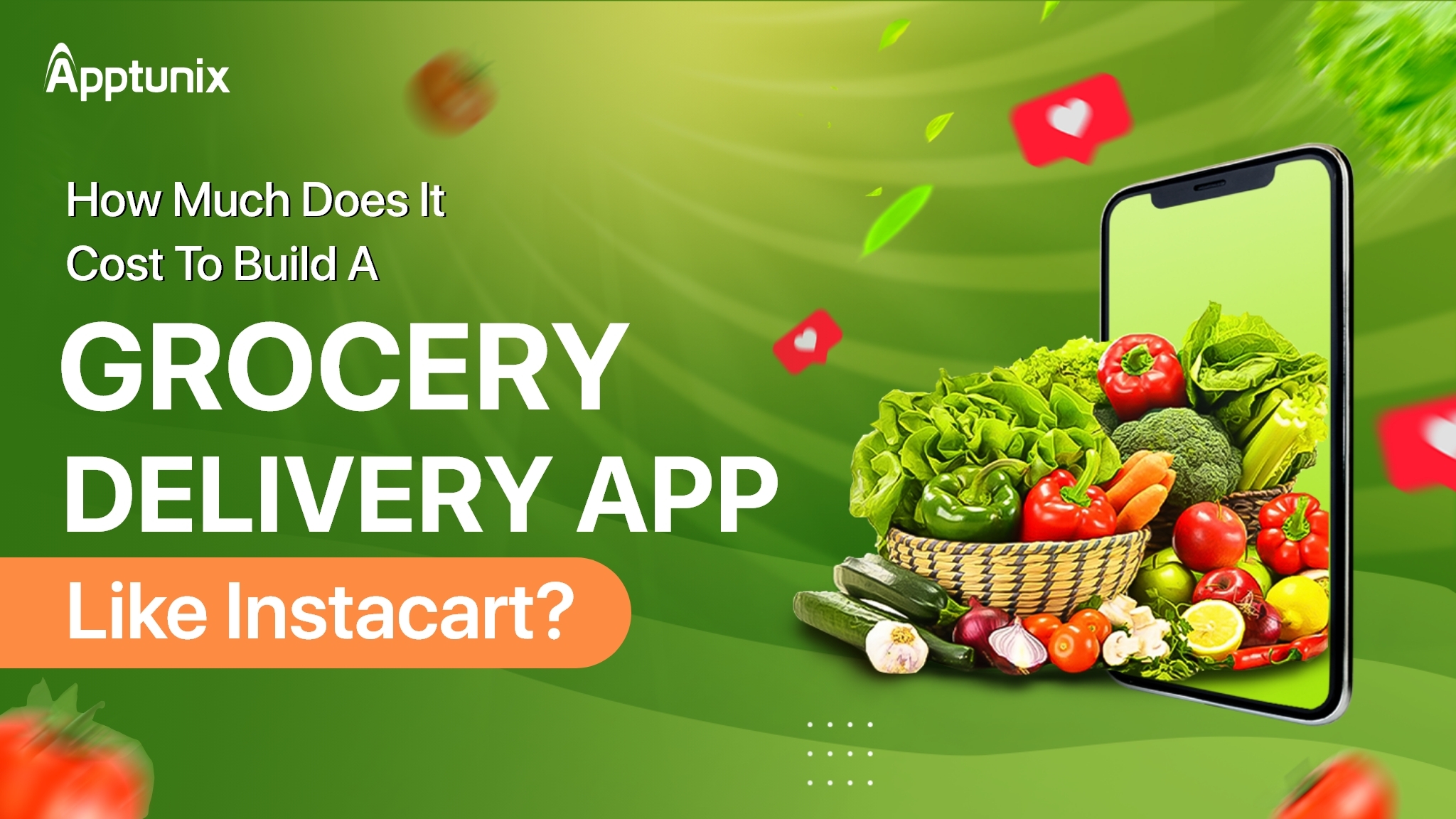
Online grocery shopping has transformed from a niche convenience into a mainstream necessity. A decade ago, most people couldn’t imagine trusting an app to pick their produce or deliver their weekly essentials. Then came Instacart, which changed the game by demonstrating how technology could seamlessly connect supermarkets, delivery partners, and customers within a single ecosystem. That’s why businesses of all sizes are asking the same question: What’s the real cost to build a grocery delivery app like Instacart?
The pandemic accelerated this trend. What started as a safety precaution quickly became a lifestyle habit. Today, people don’t just want the option of ordering groceries online—they expect it. They want speed, accuracy, and a way to avoid the hassles of crowded aisles and long checkout lines.
It’s about understanding how Instacart’s revenue model works, what features customers actually care about, and how an investment in on-demand grocery app development can become a long-term growth driver. In this blog, we’ll break it all down step by step. By the end, you’ll know exactly what it costs for Instacart clone app development, how much you’ll need to budget, and where the biggest opportunities lie.
According to Statista, the global online grocery market is forecasted to hit $2.2 trillion by 2030, with the U.S. alone expected to cross $200 billion in annual sales by 2027. But behind these numbers lies a powerful shift in consumer behavior.
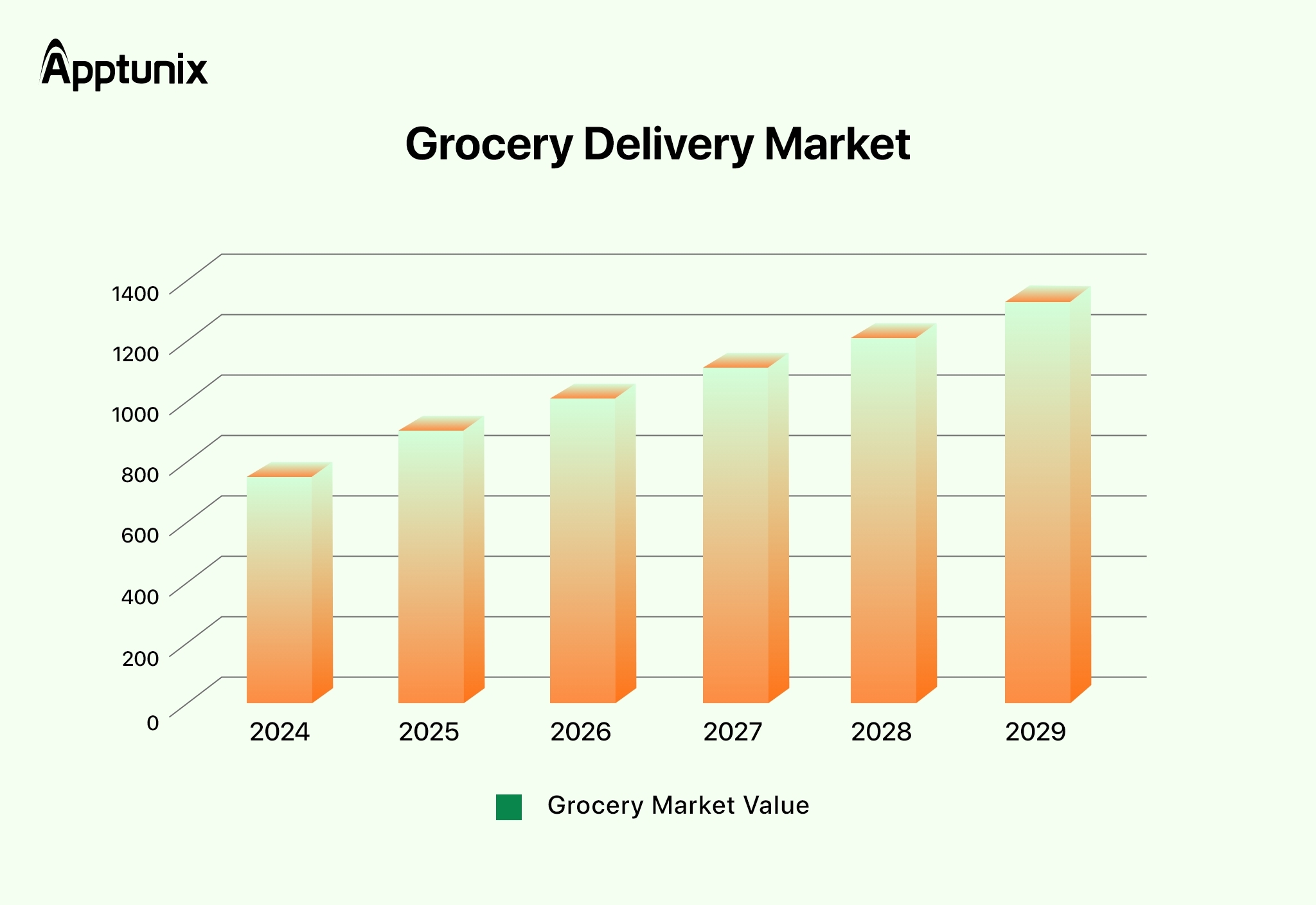
Consumers are no longer waiting until weekends to shop in stores. They’re using online grocery shopping apps to order essentials during coffee breaks, to schedule recurring deliveries, and to access a wider variety of products than they’d find on a store shelf. With a few taps, they get back the most valuable commodity—time. And in today’s lifestyle, time equals loyalty.
For entrepreneurs, this surge presents a once-in-a-generation opportunity. With on-demand grocery app development, startups can carve out niche markets by targeting unique demands—whether it’s organic produce, farm-to-door delivery, or premium imported products. Instead of battling head-to-head with Instacart or Walmart, many new businesses are thriving by going hyperlocal or focusing on specialized inventory.
For established retailers and supermarket chains, investing in grocery marketplace app development is no longer optional—it’s survival. Customers compare prices, track promotions, and read reviews online before making decisions. Without a custom grocery app development strategy, even trusted retail brands risk losing market share to more agile digital-first competitors.
One thing is certain: the opportunity is massive, but it won’t last forever. Customers are quick to switch apps if they find faster delivery, smoother UX, or better deals. That means businesses looking to build a grocery app like Instacart must act fast, prioritize flawless execution, and invest in scalable grocery app development services.
In other words, the market is there. The customers are ready. The only question is: will your business be the one they order from?

Finding a suitable business model will be an easy task if you know your business requirements. However, if you are unsure how your business idea may perform in the market, here are the top 5 business models for on-demand grocery applications you can choose.
1. The Inventory ModelThe inventory model has prominence to offer convenience to single-product shops. A platform with this model will supply directly from multiple providers. The orders will be picked up from the customers and delivered to the required location via an internal/external network.
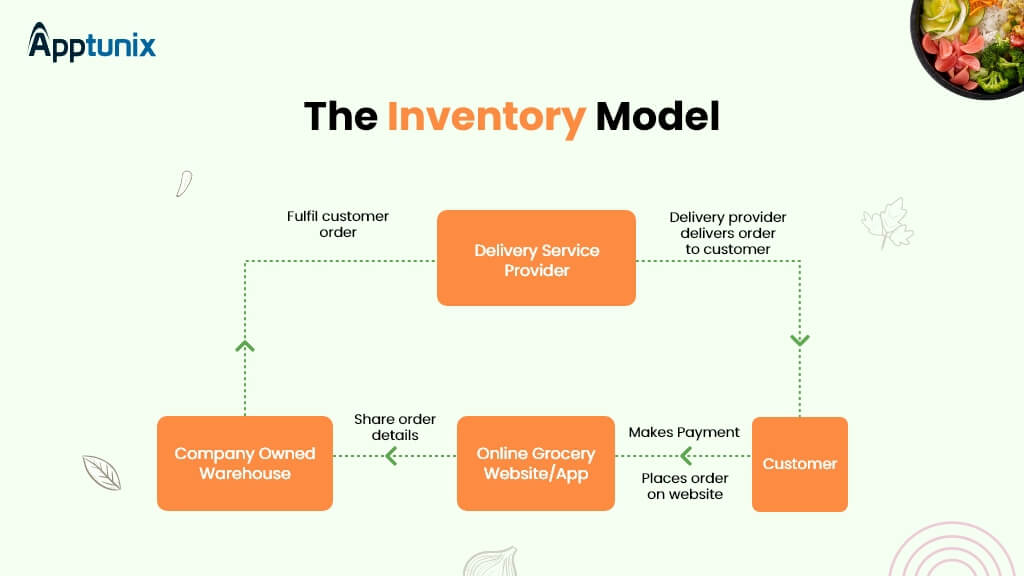
Various businesses use the inventory model to check if the production and delivery of the goods are consistent. Furthermore, profit margins are higher when a company manages its supply chain totally by purchasing directly from the company. For instance, Big Basket uses a similar model to sell goods to retailers, distributors, etc., and then store them in the warehouse.
The approach is a little costly since it necessitates the construction of a warehouse, quality control, warehouse administration, and transportation. Suppose products are not used within a specific time frame. In that case, users can remove them, and considering the initial investments, this model for developing an app like Instacart seems promising for the grocery market.
2. The Multi-Vendor Marketplace ModelMost platforms do not handle the stock of goods on their own, and to simplify the process, the platform builds a bridge between the consumers and the store owners so that the users can order their groceries, which will be given to the stores directly.
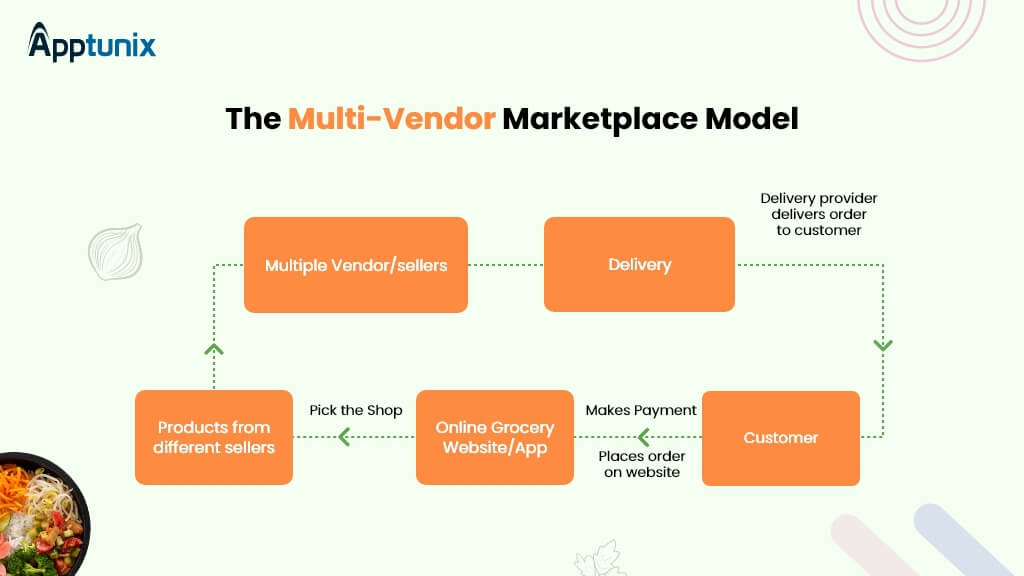
The shipping services are handled through an internal logistics network that helps businesses hassle-free ship groceries to their customers under the stores’ names. Because of the market success, a multi-vendor model has become an excellent addition to the online or on-demand grocery framework. You can simply follow this strategy if you use a multi-seller module for your grocery Instacart .
3. The Shopping ModelThe shopping model is one of the most famous and most-used models. It is pretty similar to the multi-seller model, except a user does not get to pick the store they want to purchase the groceries from before placing any order. The platform implies its distribution network for the same. Once an order is placed, the platform passes it to the vendors who buy the goods and deliver them to the customers.

Instacart also uses the shopping model. The business calls its delivery agents “shoppers” who purchase groceries on behalf of the consumers. This model has contributed to many businesses’ ample storage and supply network. With this business model for your app like Instacart, your business will scale new heights.
4. The Hyper-Local ModelAs the name implies, a hyper-local marketplace is a market that fulfills the requirements of consumers in small regions. A walk about your neighborhood will lead you to a similar store that caters to almost all residents’ needs, albeit tiny and limited but self-sufficient.

The model has a 3-tier customer strategy where customers can order required groceries and get them delivered using an app like Instacart.
The unique selling point of the businesses working on a hyper-local business model is the eagerness to offer products and services in record time. As a result, the success of various on-demand grocery stores has taken a radical direction in ordering and delivery services.
5. The Online Selling ModelBusinesses with the online selling model have various outlets as a source of money. The maximum number of sales are generated from the grocery supply and multi-seller established grocery platforms. Some of the popular revenue streams are merchandising, commissions, subscriptions, service charges, promotions, memberships, etc.

If you’re planning to build a grocery app like Instacart, one of the smartest moves is to first understand what makes Instacart’s business model so successful. Unlike traditional retailers, Instacart doesn’t own warehouses or stock shelves. Instead, it positions itself as a tech-powered middleman, connecting three stakeholders: This asset-light approach is the reason Instacart scaled so efficiently, without the overhead costs of running a logistics-heavy business.
Instacart has designed a model that generates income from multiple sources, creating both stability and scalability. Here’s how:
1. Delivery Fees
Customers pay between $3.99 to $7.99 per order, depending on delivery timing and cart value. This ensures consistent per-transaction revenue.
2. Subscription Model (Instacart+)
For $9.99 per month or $99 annually, subscribers enjoy unlimited free deliveries on qualifying orders, reduced service fees, and exclusive offers. Subscriptions drive predictable recurring revenue while increasing customer loyalty.
3. Retailer Commissions
Every order placed through Instacart comes with a commission fee for partner stores. Retailers benefit from increased digital sales without building their own delivery infrastructure, while Instacart gets a cut of each transaction—a clear win-win.
4. In-App Advertising
One of the fastest-growing streams, Instacart allows brands to pay for premium product placements inside the app. These advertising revenues have grown into a multi-million-dollar business line, making the platform not just a delivery service, but also a digital marketing channel for FMCG brands.
The strength of the Instacart business model lies in diversification. It doesn’t rely solely on delivery fees, which can be price-sensitive. Instead, it spreads revenue across subscriptions, partnerships, commissions, and advertising, creating a balanced and future-proof structure.
For entrepreneurs and enterprises investing in grocery app development services, the key takeaway is this: don’t put all your eggs in one basket. If you want your app to be sustainable and investor-ready, design multiple revenue streams from the very beginning. With the right model, your app can thrive in a hyper-competitive market where user acquisition costs are high, but customer lifetime value can be even higher.
When businesses ask about the cost to build a grocery delivery app like Instacart, the answer often comes down to features. Features decide not just the customer experience but also the complexity of development. The more you add, the higher the grocery delivery app development cost. But the right features also unlock growth, retention, and monetization opportunities.
Here’s a breakdown of what you absolutely need:
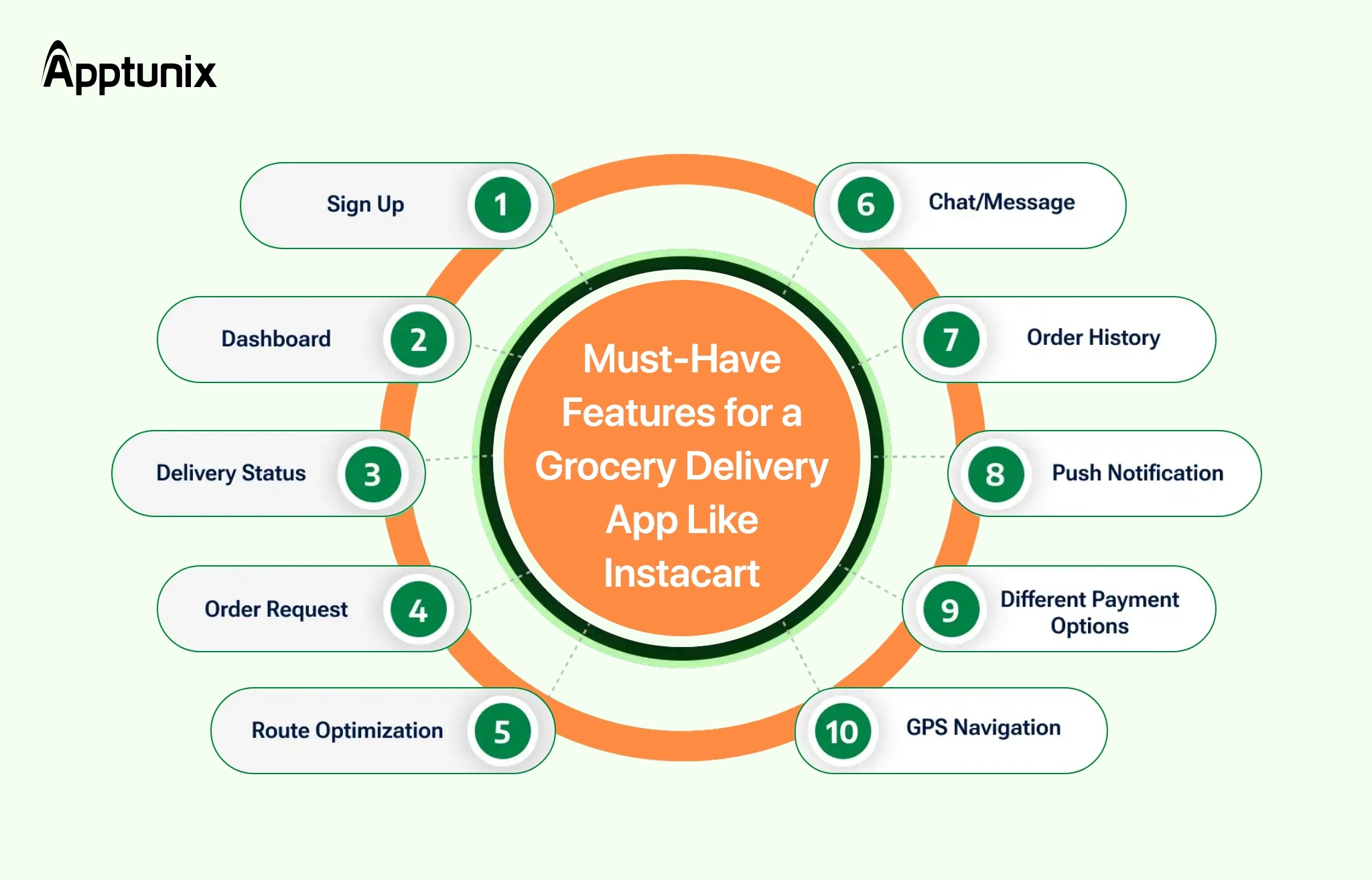
Customers are the heart of the business. If they don’t love the app, nothing else matters.
Your delivery partners need the right tools to stay efficient and motivated.
Behind the scenes, you need a control center to keep everything running smoothly.
If you’re serious about building a long-term platform, advanced features can set you apart.
The real value of working with an experienced grocery delivery app development company is knowing how to prioritize. Not every feature has to be part of your MVP. Smart planning ensures you launch quickly without overspending, while leaving room to scale with custom grocery app development as demand grows.

Let’s be clear: your tech stack can make or break the app. It impacts how fast your platform runs, how secure it is, and how much you’ll pay for updates down the road. The Instacart app development cost is closely tied to these technology choices.
The Instacart app development cost varies greatly depending on how advanced you want your tech stack to be. For instance, a simple Firebase + React Native app is cheaper upfront, while a highly scalable AWS + Node.js + MongoDB setup will cost more but last longer. Partnering with an experienced grocery delivery app development company like Apptunix ensures you pick the right stack from day one, saving both money and headaches down the road.
Let’s get into the numbers. When businesses ask about the cost to build a grocery delivery app like Instacart, the honest answer is: it depends on scope. Every feature you add, every platform you target, and every integration you choose will shift the budget. That said, we can outline some realistic ranges to give you a solid starting point.
So, when businesses ask about the grocery delivery app development cost, the honest answer is: it depends on scope, team, and ambition. That’s why the planning phase of defining must-have features, selecting the right tech stack, and choosing the right partner is so critical. The wrong decisions here don’t just increase cost; they can kill scalability before you even start. The cost to build a grocery delivery app like Instacart depends on dozens of choices you make along the way. But you can get clarity by understanding the factors that matter most.
The takeaway: Your investment depends on where you are in your journey. If you’re validating an idea, start small. If you’re scaling aggressively, prepare for enterprise-level budgets. Either way, working with an experienced grocery marketplace app development partner helps you invest wisely instead of overspending in the wrong areas.
Most Recommended: How Much Does it Cost to Build a Mobile App?
Budget is only half the story. Time-to-market is equally critical. The faster you can launch, the quicker you can capture customers and refine based on real-world feedback. Here’s a realistic timeline breakdown for online grocery shopping app development:
This is where ideas turn into blueprints. You’ll work with your development team to define requirements, research competitors, and lock down the feature set for your MVP. Clear planning here saves weeks (and thousands of dollars) later.
Design is where your brand personality meets usability. Wireframes, prototypes, and design systems are created at this stage. A well-designed interface can dramatically reduce customer drop-offs and make your app feel trustworthy.
This is the most time-intensive stage. Developers build out your customer app, delivery partner app, and admin panel while integrating APIs, payment gateways, and cloud hosting. The complexity of your feature set will decide whether you’re closer to three months or six.
Every app has bugs—it’s how quickly you catch and fix them that matters. QA teams test across devices, OS versions, and real-world scenarios to ensure smooth performance. For apps handling payments and personal data, security testing is especially critical.
The launch is just the start. Once your app hits the market, expect to spend weeks monitoring feedback, fixing issues, and pushing updates. Post-launch support is where strong partnerships with a grocery delivery app development company really pay off.
When companies think about launching a grocery delivery platform, they don’t just want an app. They want a partner who understands business models, technology, and scale. That’s where Apptunix stands out.
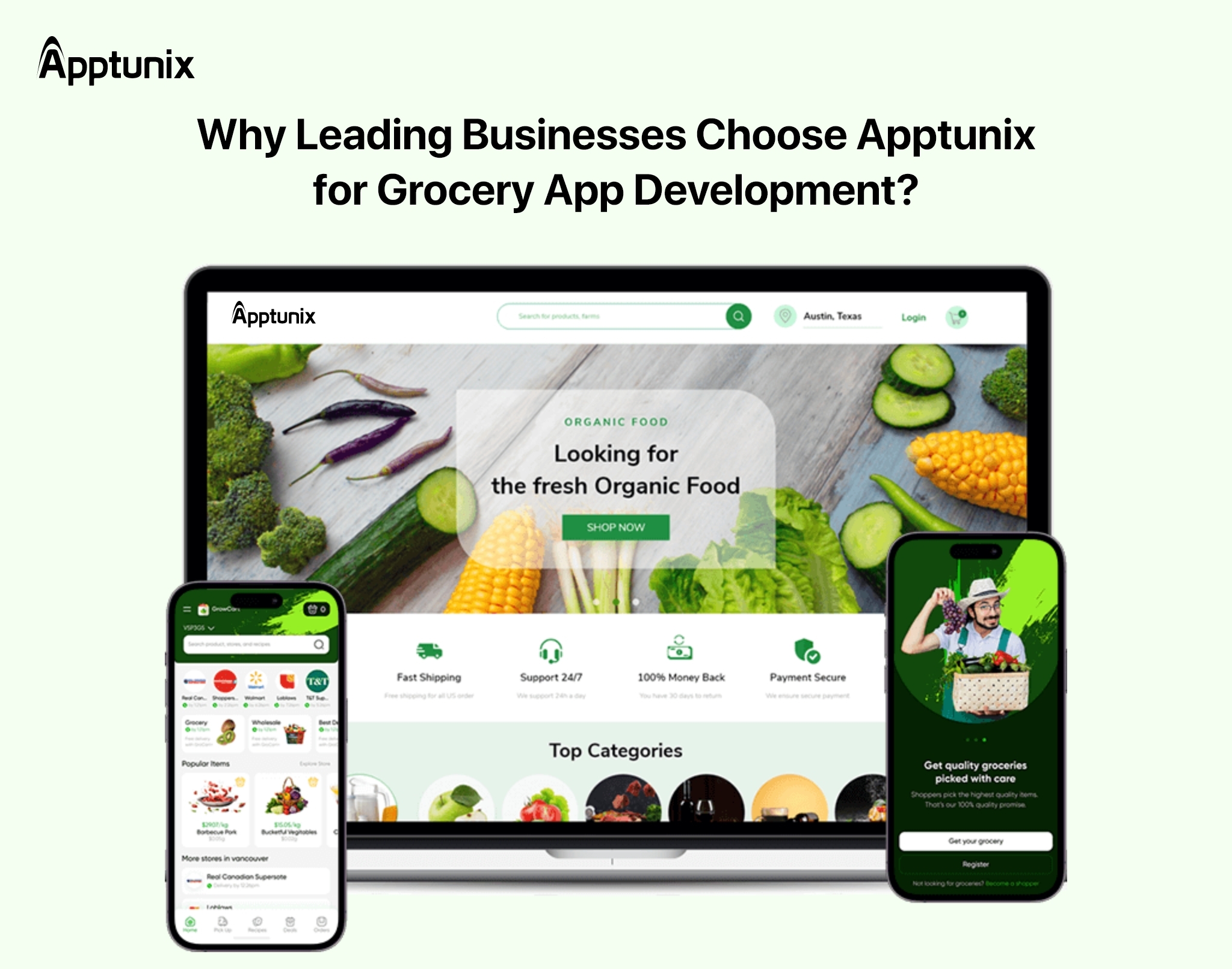
Apptunix has been helping businesses worldwide with on-demand grocery app development for more than a decade. We don’t build cookie-cutter solutions. We design platforms that align with your unique market, customers, and long-term growth plan. Whether it’s grocery marketplace app development for multi-vendor platforms or online grocery shopping app development for single brands, our team has done it all at scale.
Proven Expertise: We’ve delivered 2,000+ mobile apps globally, including successful on-demand platforms across food, retail, and delivery.
Business-First Approach: We study models like the Instacart business model to ensure your app isn’t just functional but profitable from day one.
Custom-Built for Growth: Our custom grocery app development services ensure you get a platform that scales, adapts, and outpaces competitors.
Technology that Delivers: From AI-driven personalization to advanced analytics dashboards, we design with the future in mind.
Global Recognition: With offices in the USA, UAE, and India, Apptunix is a trusted grocery delivery app development company for startups and enterprises across the world.
Let’s be real: the grocery delivery market isn’t slowing down. Customers now expect speed, convenience, and reliability at their fingertips. Businesses that act now will own this market. The opportunity is clear, but success depends on choosing the right development partner.
Apptunix is that partner. We’ve mastered the playbook on how to build a grocery app like Instacart, and we bring more than just code to the table. From analyzing revenue models to cutting development costs without sacrificing quality, we position you to win.
The on-demand grocery delivery app development is an investment in your future—and with Apptunix, you know that investment is going into a product built for performance, security, and scale.
If you’re serious about entering the space, don’t settle for generic solutions. Work with the company that global brands trust.
Talk to Apptunix today about the cost to build a grocery delivery app like Instacart. Let’s create the platform that puts your business at the center of the online grocery revolution.

Q 1.What is the cost to build a grocery delivery app like Instacart?
The cost to build a grocery delivery app like Instacart generally ranges from $25,000 for a basic MVP to $100,000+ for a full-featured platform. The final budget depends on features, tech stack, design complexity, and whether you choose iOS, Android, or both.
Q 2.What factors influence the Instacart app development cost?
Key factors include app features, technology stack, third-party integrations, UI/UX design, backend scalability, and developer expertise. Adding AI recommendations, real-time order tracking, and multi-language support will raise the Instacart app development cost.
Q 3.How long does it take to build grocery app like Instacart?
On average, it takes 4–8 months to build a grocery app like Instacart. A simple MVP may take around 3–4 months, while an advanced grocery marketplace app development project can take longer due to complex features like logistics management and in-app advertising.
Q 4.What are the must-have features in online grocery shopping app development?
Essential features include user onboarding, product catalog, shopping cart, payment integration, real-time order tracking, push notifications, and admin dashboard. Advanced grocery app development services also include loyalty programs, AI-driven recommendations, and multiple delivery options.
Q 5.Is it better to build a custom grocery app or use an off-the-shelf solution?
Custom grocery app development offers scalability, security, and unique branding, while off-the-shelf apps are cheaper but less flexible. If you plan long-term growth, custom grocery app development is a smarter investment.
Q 6.How does Apptunix help reduce grocery delivery app development cost?
Apptunix follows an agile development approach, reusable components, and cost-effective project planning to minimize unnecessary expenses. This ensures businesses get high-quality grocery app development services without overspending.
Q 7.Why should I choose Apptunix as my grocery delivery app development company?
Apptunix is a trusted grocery delivery app development company with 12+ years of experience, 300+ global experts, and 2,500+ apps delivered. From startups to enterprises, we specialize in on-demand grocery app development that’s scalable, secure, and tailored to business goals.
Q 8.Can Apptunix handle grocery marketplace app development at scale?
Yes. Apptunix has expertise in grocery marketplace app development for both regional and enterprise-level businesses. We build apps that support multiple vendors, real-time inventory sync, advanced analytics, and high user volumes without compromising performance.
Q 9.How can grocery delivery apps make money like Instacart?
Revenue streams include delivery fees, subscription plans, retailer commissions, and in-app advertising. A well-planned online grocery shopping app development strategy should include multiple monetization models for long-term growth.
Q 10.What’s the best way to get started with grocery delivery app development?
The first step is to define your business model and features. Next, consult with an expert grocery delivery app development company like Apptunix to get a detailed cost estimate, tech stack guidance, and launch plan.
Get the weekly updates on the newest brand stories, business models and technology right in your inbox.
Book your free consultation with us.
Book your free consultation with us.





